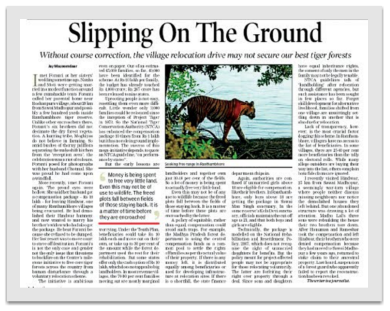

 forest rights, conservation and dilemmas of growth
forest rights, conservation and dilemmas of growth
 © mazoomdaar 2011
© mazoomdaar 2011

Slipping on the ground
Without course correction, the village relocation drive may not secure our best tiger forests
Jay Mazoomdaar | 1 July, 2010 | THE TIMES OF INDIA
I met Foranti at her sisters' wedding sometime ago. Nanha and
Moti were getting married in a modest function around a few
ramshackle tents Foranti called her parental home near
Roshanpura village, about 20 km from Sawai Madhopur and
possibly a few hundred yards inside Ranthambhore tiger reserve.
Unlike other encroachers there, Foranti's six brothers did not
decimate the dry forest vegetation. A hunting tribe, Moghiyas do
not believe in farming. So amid bushes of thorny juliflora
separating the makeshift kitchen from the 'reception area', the
celebration was a riot of colours. Foranti posed for photographs
with her husband Chotmal. She was proud he had come upon a
windfall.
More recently, I met Foranti again. The proud eyes were hollow.
She said her husband got a compensation package -- Rs 10 lakh --
for leaving Hindwar, one of many Ranthambhore villages being
evacuated. He had demolished their Hindwar hutment and now
wanted to marry his brother's widow who had also got the package. He beat Foranti because she refused to be dumped. Her last resort
was to move court to stave off destitution. Foranti's is not the only case and gender not the only issue that threatens to backfire on the
Centre's milestone initiative to free core tiger forests across the country from human disturbance through a voluntary relocation
scheme.
The initiative is ambitious even on paper. Out of an estimated 65,000 families, so far, 40,000 have been identified for the scheme. At
Rs 10 lakh per family, the budget has already touched Rs 4,000 crore; Rs 267 crore has been released to nine states.
Uprooting people is not easy, resettling them even more difficult. Little wonder only 3,000 families could be relocated since the
inception of Project Tiger in 1973. So the National Tiger Conservation Authority (NTCA) has enhanced the compensation package 10
times from Rs 1 lakh but it has no role in ground implementation. The success of this mega-initiative depends, to quote an NTCA
guideline, "on performance by states".
But the early lessons are worrying. Under the Tenth Plan, beneficiaries could take Rs 10 lakh each and move out on their own, or take
up to 30 per cent of the amount while the forest department used the rest for their rehabilitation. But some states offer only the cash
option of Rs 10 lakh, which does not appeal to big landholders. In most revenue villages, the 70-80 per cent families moving out are
mostly marginal landholders and together own just 30-40 per cent of the fields. So a lot of money is being spent to actually free very
little land.
Even this may not be of any use to wildlife because the freed plots fall between the fields of those staying back. It is a matter of time
before these plots are encroached by the latter.
A policy of equitable, rather than equal, compensation could avoid such traps. For example, the Madhya Pradesh forest department is
using the central compensation funds as a common pool to settle the rights of families as per the actual value of their property. If there
is any money left, it is distributed equally among beneficiaries or used for developing infrastructure at relocation sites. If there is a
shortfall, the state finance department chips in.
Again, authorities are confused if unmarried girls above 18 are eligible for compensation, like their brothers. In Ranthambhore, only
boys above 18 are getting the package in Sawai Man Singh sanctuary. In the same reserve's Kela Devi sanctuary, officials maintain the
cut-off age is 21, and that both boys and girls are eligible.
Technically, the package is modelled on the National Rehabilitation and Resettlement Policy, 2007, which does not recognise the right
of unmarried daughters for benefits. But the policy meant for project-affected people may not be appropriate for those relocating
voluntarily. The latter are forfeiting their right over property through a deal. Since sons and daughters have equal inheritance rights,
the consent of only the men in the family may not be legally tenable.
NTCA guidelines talk of 'handholding' after relocation through different agencies, but such assistance has been sought in few places so
far. Forget skill development for alternative livelihood, families shifted from one village are unwittingly settling down in another that
is also due for relocation.
Lack of transparency, however, is the most crucial factor dogging this scheme. In Ranthambhore, villagers have no access to the list of
beneficiaries. In some villages, there are 25-40 per cent more beneficiaries than the tally on electoral rolls. While many allege
outsiders are buying their way into the list, others complain bona fide claims are ignored.
I recently visited Hindwar, 25 km from Sawai Madhopur, a seemingly war-torn village where people neither discuss missing
neighbours nor notice the demolished houses they left behind. But one abandoned structure was drawing a lot of attention. Madho
Lal's three sons were rebuilding the house their two brothers tore down. After Hanuman and Rameshar took the compensation and left
Hindwar, their brothers who were denied compensation because they had moved to Sawai Madhopur a few years ago, returned to stake
claim to their ancestral property. Last heard, suspension of a forest guard who apparently failed to report the reconstruction has been
revoked.
The author is an independent journalist







 Home | Reports | Related Articles | Resources | Gallery | Feedback | Contact | About
Home | Reports | Related Articles | Resources | Gallery | Feedback | Contact | About














 Home | Reports | Related Articles | Resources | Gallery | Feedback | Contact | About
Home | Reports | Related Articles | Resources | Gallery | Feedback | Contact | About














